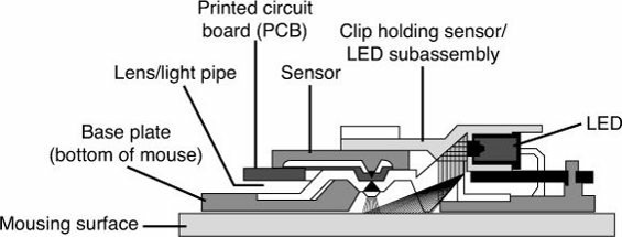Hardware Reference
In-Depth Information
Figure 15.10. The bottom of the Logitech iFeel optical mouse.
Their versatility and low maintenance (not to mention that neat red or blue glow out the sides!) make
optical mice an attractive choice, and the variety of models available from both vendors means you
can have the latest optical technology for about the price of a good ball-type mouse.
Figure 15.11
shows the interior of a typical optical mouse.
Figure 15.11. The LED or laser inside an optical mouse illuminates the surface by blinking many
times per second. The light is reflected from the mousing surface back to the sensor, which
converts the information into digital form and sends it to the computer.
Optical mice are available as corded or wireless models, which use either IR or RF transceivers to
replace the cable. A receiver is plugged into the USB or mouse port, and the battery-powered mouse
contains a compatible transmitter. Wireless ball-type mice are usually much larger than ordinary mice
because of the need to find room for both the bulky ball mechanism and batteries, but wireless optical
mice are about the same size as high-end corded mice.
Tip
Corded mice have cables that are typically 4 to 6 feet in length. If you have a choice on the
length of cable to buy, get a longer one. This allows easier placement of the mouse in relation





